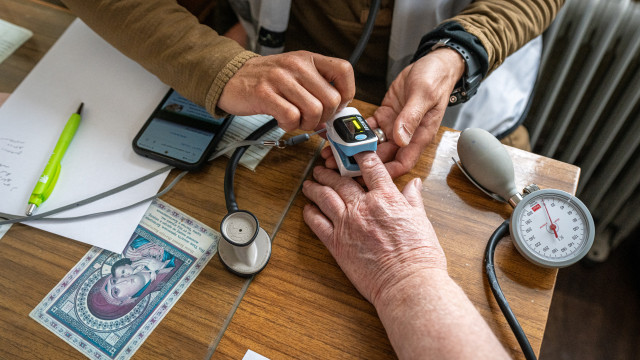





























See Also
See Again
© Getty Images
0 / 30 Fotos
What is influenza?
- Influenza, also known as the flu, is an extremely contagious viral infection that affects air passages in the lungs. Amongst other things, it can cause a high fever, body aches, and cough.
© Shutterstock
1 / 30 Fotos
Is the flu dangerous?
- The flu is considered one of the most severe and common viral illnesses that happens predominately in winter. Most sick children have the flu for less than a week, while others with more serious symptoms need to be hospitalized.
© Shutterstock
2 / 30 Fotos
Types of flu viruses: A and B
- Flu types A and B cause epidemics or widespread illness almost every winter. They can result in people needing to go to the hospital, or even dying.
© Shutterstock
3 / 30 Fotos
Mutations
- Public health officials are focusing on stopping the spread of types A and B, but this remains a challenge because the viruses change and mutate often, so people are then exposed to new types every year.
© Shutterstock
4 / 30 Fotos
Type C
- Mild respiratory symptoms are a result of this particular type of flu virus. It is considered less severe compared to types A and B.
© Shutterstock
5 / 30 Fotos
How is the flu virus spread by children?
- The flu can be passed from one child to another when they cough or sneeze. It's also possible to transfer the virus when a child touches their nose or mouth after touching something infected with the flu virus.
© Shutterstock
6 / 30 Fotos
Additional ways it can spread
- Influenza can also be passed through using the same utensils or drinkware as someone who is infected.
© Shutterstock
7 / 30 Fotos
When are people the most contagious?
- The most contagious period is the 24 hours before flu-like symptoms start. After about five to seven days, the risk of infecting someone else ends.
© Shutterstock
8 / 30 Fotos
Why is it especially prevalent in children?
- Children often touch many surfaces and then touch their mouth, nose, or eyes and become infected. The flu is easy to spread, and kids are especially at risk.
© Shutterstock
9 / 30 Fotos
Why are children at greater risk for the flu than adults?
- There are several reasons that children are at more risk than adults when it comes to the flu. Some reasons include that they haven't received the flu vaccine or don't usually (or ever) wash their hands after they touch infected surfaces.
© Shutterstock
10 / 30 Fotos
Increased risk
- Children who are younger or those with certain underlying health conditions are often at an increased risk of a flu-induced hospital stay and having severe, complicated symptoms.
© Shutterstock
11 / 30 Fotos
What symptoms do children have? - Children can have various symptoms. The most common ones include a fever, which may be as high as 103°F (39.44°C ) to 105°F (40.56°C), body aches, which may be severe, and a headache.
© Shutterstock
12 / 30 Fotos
Additional symptoms - Other symptoms that can occur are a sore throat, an increasingly worse cough, tiredness, and a runny or stuffy nose.
© Shutterstock
13 / 30 Fotos
Rare symptoms
- Infrequently, symptoms might include nausea, vomiting, or diarrhea. Be sure to keep an eye on symptoms and speak with the doctor as things progress.
© Shutterstock
14 / 30 Fotos
How long before a child recovers?
- Children who have the flu usually recover after a few days. However, if they're not careful it can progress to pneumonia, or, in worst-case scenarios, even death.
© Shutterstock
15 / 30 Fotos
Cold vs. the flu
- A common cold is often quite mild and will go away after a few days. The flu, however, can cause severe problems and symptoms that can lead to hospitalization.
© Shutterstock
16 / 30 Fotos
How is the flu diagnosed in a child?
- Your child's doctor or healthcare provider will ask about the symptoms your child is experiencing. They will also give your child a physical exam, at which point a flu diagnosis can usually be made. However, in some scenarios further tests such as a nose or throat swab will be done.
© Shutterstock
17 / 30 Fotos
How is the flu treated in a child?
- Your child's age, symptoms, and general health will impact the treatment they receive. It's also important to consider how severe the flu is.
© Shutterstock
18 / 30 Fotos
Treatment options
- It's important to consult a doctor before your child takes any medications. One common option to help with flu symptoms is acetaminophen, which can help lessen body aches and fever.
© Shutterstock
19 / 30 Fotos
Antiviral medicine
- Antiviral medicines may help ease symptoms and even shorten the length of illness. They can also help lessen the chances of developing flu-related ear infections.
© Shutterstock
20 / 30 Fotos
Pro tips
- Antibiotics are only effective against symptoms of the flu, not in curing it. You should talk to your child's healthcare provider about the risks, benefits, and possible side effects before starting any medicine.
© Shutterstock
21 / 30 Fotos
Things to ensure your child has
- Be sure your child rests a lot, and that they drink plenty of fluids to stay hydrated.
© Shutterstock
22 / 30 Fotos
Possible flu complications
- If your child has severe symptoms, including breathing problems, then they may need to go to, and stay in, the hospital. The flu can lead to lung infections such as pneumonia.
© Shutterstock
23 / 30 Fotos
Other health conditions
- Children with other health conditions that affect their breathing, such as asthma, are at a greater risk for complications from the flu.
© Shutterstock
24 / 30 Fotos
How can I help prevent the flu in my child?
- You can help your child remain healthy by getting them an annual flu vaccine before flu season starts. If there are questions about the efficacy of the flu vaccine, be sure to talk with your doctor or medical provider.
© Shutterstock
25 / 30 Fotos
Post-shot temporary symptoms
- If your child gets the flu shot, there can sometimes be mild side effects, such as soreness in the arm where the shot was given, a headache, or a low-grade fever for about one day following the shot.
© Shutterstock
26 / 30 Fotos
How to limit exposure - To help keep your child healthy, try to limit their contact with infected people. Additionally, have your child wash their hands often.
© Shutterstock
27 / 30 Fotos
Additional options
- Consider having your child wear a medical mask when in contact with others, especially large groups of people.
© Shutterstock
28 / 30 Fotos
When should I call my child’s doctor?
- It is important to closely monitor your child's health and any flu-like symptoms. Call your healthcare provider if your child has symptoms that don’t get better, get worse, or if new symptoms arise. Sources: (Cleveland Clinic) (Johns Hopkins Medicine) See also: Baby's first year—how to prepare for and prevent illnesses
© Shutterstock
29 / 30 Fotos
© Getty Images
0 / 30 Fotos
What is influenza?
- Influenza, also known as the flu, is an extremely contagious viral infection that affects air passages in the lungs. Amongst other things, it can cause a high fever, body aches, and cough.
© Shutterstock
1 / 30 Fotos
Is the flu dangerous?
- The flu is considered one of the most severe and common viral illnesses that happens predominately in winter. Most sick children have the flu for less than a week, while others with more serious symptoms need to be hospitalized.
© Shutterstock
2 / 30 Fotos
Types of flu viruses: A and B
- Flu types A and B cause epidemics or widespread illness almost every winter. They can result in people needing to go to the hospital, or even dying.
© Shutterstock
3 / 30 Fotos
Mutations
- Public health officials are focusing on stopping the spread of types A and B, but this remains a challenge because the viruses change and mutate often, so people are then exposed to new types every year.
© Shutterstock
4 / 30 Fotos
Type C
- Mild respiratory symptoms are a result of this particular type of flu virus. It is considered less severe compared to types A and B.
© Shutterstock
5 / 30 Fotos
How is the flu virus spread by children?
- The flu can be passed from one child to another when they cough or sneeze. It's also possible to transfer the virus when a child touches their nose or mouth after touching something infected with the flu virus.
© Shutterstock
6 / 30 Fotos
Additional ways it can spread
- Influenza can also be passed through using the same utensils or drinkware as someone who is infected.
© Shutterstock
7 / 30 Fotos
When are people the most contagious?
- The most contagious period is the 24 hours before flu-like symptoms start. After about five to seven days, the risk of infecting someone else ends.
© Shutterstock
8 / 30 Fotos
Why is it especially prevalent in children?
- Children often touch many surfaces and then touch their mouth, nose, or eyes and become infected. The flu is easy to spread, and kids are especially at risk.
© Shutterstock
9 / 30 Fotos
Why are children at greater risk for the flu than adults?
- There are several reasons that children are at more risk than adults when it comes to the flu. Some reasons include that they haven't received the flu vaccine or don't usually (or ever) wash their hands after they touch infected surfaces.
© Shutterstock
10 / 30 Fotos
Increased risk
- Children who are younger or those with certain underlying health conditions are often at an increased risk of a flu-induced hospital stay and having severe, complicated symptoms.
© Shutterstock
11 / 30 Fotos
What symptoms do children have? - Children can have various symptoms. The most common ones include a fever, which may be as high as 103°F (39.44°C ) to 105°F (40.56°C), body aches, which may be severe, and a headache.
© Shutterstock
12 / 30 Fotos
Additional symptoms - Other symptoms that can occur are a sore throat, an increasingly worse cough, tiredness, and a runny or stuffy nose.
© Shutterstock
13 / 30 Fotos
Rare symptoms
- Infrequently, symptoms might include nausea, vomiting, or diarrhea. Be sure to keep an eye on symptoms and speak with the doctor as things progress.
© Shutterstock
14 / 30 Fotos
How long before a child recovers?
- Children who have the flu usually recover after a few days. However, if they're not careful it can progress to pneumonia, or, in worst-case scenarios, even death.
© Shutterstock
15 / 30 Fotos
Cold vs. the flu
- A common cold is often quite mild and will go away after a few days. The flu, however, can cause severe problems and symptoms that can lead to hospitalization.
© Shutterstock
16 / 30 Fotos
How is the flu diagnosed in a child?
- Your child's doctor or healthcare provider will ask about the symptoms your child is experiencing. They will also give your child a physical exam, at which point a flu diagnosis can usually be made. However, in some scenarios further tests such as a nose or throat swab will be done.
© Shutterstock
17 / 30 Fotos
How is the flu treated in a child?
- Your child's age, symptoms, and general health will impact the treatment they receive. It's also important to consider how severe the flu is.
© Shutterstock
18 / 30 Fotos
Treatment options
- It's important to consult a doctor before your child takes any medications. One common option to help with flu symptoms is acetaminophen, which can help lessen body aches and fever.
© Shutterstock
19 / 30 Fotos
Antiviral medicine
- Antiviral medicines may help ease symptoms and even shorten the length of illness. They can also help lessen the chances of developing flu-related ear infections.
© Shutterstock
20 / 30 Fotos
Pro tips
- Antibiotics are only effective against symptoms of the flu, not in curing it. You should talk to your child's healthcare provider about the risks, benefits, and possible side effects before starting any medicine.
© Shutterstock
21 / 30 Fotos
Things to ensure your child has
- Be sure your child rests a lot, and that they drink plenty of fluids to stay hydrated.
© Shutterstock
22 / 30 Fotos
Possible flu complications
- If your child has severe symptoms, including breathing problems, then they may need to go to, and stay in, the hospital. The flu can lead to lung infections such as pneumonia.
© Shutterstock
23 / 30 Fotos
Other health conditions
- Children with other health conditions that affect their breathing, such as asthma, are at a greater risk for complications from the flu.
© Shutterstock
24 / 30 Fotos
How can I help prevent the flu in my child?
- You can help your child remain healthy by getting them an annual flu vaccine before flu season starts. If there are questions about the efficacy of the flu vaccine, be sure to talk with your doctor or medical provider.
© Shutterstock
25 / 30 Fotos
Post-shot temporary symptoms
- If your child gets the flu shot, there can sometimes be mild side effects, such as soreness in the arm where the shot was given, a headache, or a low-grade fever for about one day following the shot.
© Shutterstock
26 / 30 Fotos
How to limit exposure - To help keep your child healthy, try to limit their contact with infected people. Additionally, have your child wash their hands often.
© Shutterstock
27 / 30 Fotos
Additional options
- Consider having your child wear a medical mask when in contact with others, especially large groups of people.
© Shutterstock
28 / 30 Fotos
When should I call my child’s doctor?
- It is important to closely monitor your child's health and any flu-like symptoms. Call your healthcare provider if your child has symptoms that don’t get better, get worse, or if new symptoms arise. Sources: (Cleveland Clinic) (Johns Hopkins Medicine) See also: Baby's first year—how to prepare for and prevent illnesses
© Shutterstock
29 / 30 Fotos
Here’s what to do when your child has the flu
A parent’s guide to managing the flu at home
© Getty Images
It's that time of year: the weather is cooling down, and your child seems to catch every sickness out there. Of course, especially prevalent is the flu. This contagious, viral infection can affect air passages, making sufferers feel absolutely terrible. But when your child catches the flu, it's not only them feeling the toll!
In this gallery, you'll find out more about the flu in children and what you, the parent, can do to help them tackle it (and even prevent it to begin with). Click through now.
RECOMMENDED FOR YOU




























MOST READ
- Last Hour
- Last Day
- Last Week








